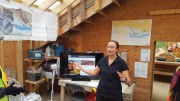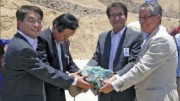It’s been a tough and ambitious foray in Canada’s Arctic for Agnico-Eagle Mines (AEM-T, AEM-N), but one that holds much promise.
Four years ago the company scoured the continents for new deposits and scooped up the Meadowbank gold asset, and then last year acquired the Meliadine gold project. Both are in Nunavut’s Kivalliq region, or what Ebe Scherkus, Agnico’s president and COO, likes to call the company’s oyster.
The Meadowbank mine is 300 km west of Hudson Bay and 70 km north of Baker Lake, the nearest community.
Some 290 km to the southeast, Agnico is developing the Meliadine project, which is 25 km north of Rankin Inlet.
The flight from Baker Lake to the Meadowbank mine via Rankin Inlet reveals a flat and serene landscape. Once on the ground, the camp facilities dominate, with little else to see. But the feeling that you’ve ventured into one of Canada’s remote and isolated corners vanishes once you enter the bustling facilities.
“We really believe there is a lot of potential in the Arctic,” Scherkus tells visitors to the mine in late June. “We believe that the early bird will get the worm.”
To date, the Meadowbank mine and Meliadine project contain nearly 29% of Agnico’s growing gold reserves and more than 38% of its gold resources, which says a lot for a company with five other producing gold mines in Quebec, Mexico and Finland.
Scherkus adds that when both mines run at full capacity, they would account for 35-50% of Agnico’s annual gold production.
After visiting the Meadowbank mine in late August, Prime Minister Stephen Harper echoed the message of the area’s prospectiveness.
“Canada’s North is full of economic potential, and innovators continue to unlock development possibilities that bring with them real economic benefits and long-term jobs for local residents,” Harper stated in a news release.
At the end of July, 289 full-time workers, or 39% of Meadowbank’s staff, were Inuit. “It’s a tough number to hit and an exceptional number that we were able to achieve,” Scherkus remarks.
Before Agnico-Eagle swooped into the region, unemployment at Baker Lake was hovering at 40%. Now it’s at 4.5%.
Along with providing jobs for residents of Baker Lake and other local communities, the company used northern-based suppliers for 41% of the $1.26 billion it spent building and running Meadowbank between 2007 and 2010.
It also shelled out $10 million in royalties to Inuit land claim organization Nunavut Tunngavik in 2010-2011.
The Conference Board of Canada notes that Nunavut’s gross domestic product jumped by 11% in 2010, largely because of the Meadowbank mine.
But to get the mine online, Agnico had to clear many hurdles. Most of them concerned building the open-pit mine and bringing it into commercial production in March 2010. And the challenges didn’t end there.
This year the company braved a hellish winter, a costly kitchen fire and lower-than-expected grades due to dilution in the pit, which dampened the company-wide performance for the second quarter. Compared to a year ago, Agnico’s company-wide production was down 8% to 239,328 oz. gold, at cash costs of US$565 per oz. for the quarter.
“It hasn’t been easy for a number of reasons, but there is tremendous optimism,” Scherkus concedes. “We believe we are on the cusp of turning this operation around.”
The kitchen fire that started on March 10 was one of the major setbacks.
“Let me tell you, it was a lot more than a grease fire in a frying pan,” Scherkus recalls. With 460 employees on-site, and a bone-chilling -60°C outside, Agnico evacuated 315 employees within 17 hours and kept a skeleton crew of 175.
Scherkus congratulated his staff during the presentation for containing the fire and preventing the camp from going up in flames. During the wee hours of the morning, the crew bulldozed the burning kitchen and dining facilities to safeguard the rest of the camp.
Agnico increased its remaining crew to 230 and ran the mill from the low-grade stockpile, but became concerned as the stockpile started dwindling. Open-pit mining, construction, drilling and other activities were curtailed, Scherkus says, so the short-handed crew could manage.
Three weeks after the fire, Agnico flew in a temporary kitchen from Phoenix, Ariz., and installed it in early April. It then converted a third of the gym into a dining room.
The company, which kept all its employees on payroll during the debacle, saw the full staff return to work by the end of April.
While sitting in the temporary dining room during lunch, Scherkus says the fire cost the company more than US$20 million, US$16 million of which went towards replacing the kitchen, while the rest was used to maintain the payroll.
Agnico says the new kitchen and dining room will arrive in August, and should be up and running by year-end.
But those millions of dollars lost during the fire didn’t account for the loss in production.
To add to the problematic second quarter, the company experienced lower grades in the open pit. The dilution, estimated at 20-30%, was partially due to moving more ore and waste during the production blasts.
The producer says it’s revising the blasting sequence so that it will be more similar to the methods used at its Pinos Altos mine in Mexico.
After the staffing-related slowdown in April, and the lower grades, Meadowbank achieved an expected lukewarm quarterly performance.
It mined 59,376 oz. gold for the period at cash costs of US$910 per oz., compared to a production of 77,676 oz. at cash costs of US$663 per oz. a year ago.
Agnico says during the first six months of 2011, the grades at Meadowbank dropped by 34% because of dilution and scheduled lower-grade ore mining.
The company anticipates higher throughput and grades at Meadowbank because it installed a permanent secondary crusher in mid-June. For July, the mill averaged 9,257 tonnes per day grading 3.08 grams gold per tonne.
“Meadowbank is really a key driver on a couple of fronts,” Sean Boyd, Agnico’s vice-chairman and CEO, says. “One certainly is to boost production as we move into the second half, and that comes from increased tonnage.”
Agnico forecasts gold production at Meadowbank to increase by 50% and costs to decrease by 15% to $80 per tonne, compared to the first six months of the year.
And if things go to plan at Meadowbank, Agnico expects company-wide production for that period to grow by 20% and total cash costs per oz. to decline by a similar percentage.
Since acquiring the property from Cumberland for US$750 million in 2007, Agnico has invested US$710 million on pre-production and another US$30 million on exploration, for a total US$1.5 billion.
During the first two years, it underwent a massive construction phase, which included building a 110-km all-season road from Baker Lake to the site. Despite the rigid regulatory environment in Nunavut, the miner completed the permitting process in three years, pouring its first gold in late February 2010.
“The federal government still has a huge umbilical cord tied to Nunavut,” Scherkus says. “There’s a lot of duplication and a lack of clarity.” He adds that things on that front are significantly improving.
Some of the hoops the producer had to jump through during the first few years at Meadowbank include building a new management team, tricky logistics and an unforgiving climate.
While Agnico was preparing Meadowbank, it also had five other mines in various development or production stages on its plate: LaRonde, Goldex, Lapa in Quebec, Kittila in Finland and Pinos Altos in Mexico. The Lapa, Kittila and Pinos Altos mines all came online in 2009.
Agnico didn’t inherit anyone from former owner Cumberland Resources, and it began a hiring spree
at Meadowbank before the 2009 recession hit. It grew from a staff of 1,000 to over 5,000 in two years. Agnico hired a mix of English, French and Inuit workers to fire up Meadowbank.
The metallurgy and processing at Meadowbank are quite straightforward, Scherkus notes. But he concedes logistics and dyke construction were difficult for the gold deposit, which rests mostly underwater.
Agnico used an in-water dyke construction method to allow for mining under shallow lakes. The company first built two dykes to close off the North Portage pit area. Some 16 million litres of water was pumped out before stripping and mining started at the pit.
The Portage pit began producing in late 2009, and is expected to generate ore until 2014.
Goose Island is anticipated to produce from 2013 to 2015, following the dewatering and overburden stripping of the Bay-Goose dyke in 2013.
The miner says the Vault pit, following the dewatering of Vault Lake, could be mined from 2015 to the end of the mine’s life in 2019.
Although another year – and half of the dyke construction – remains, the company believes it is largely over the hump.
The three current and planned open pits at Meadowbank are all within 7 km of a processing plant.
Gold mineralization at the deposits is often associated with intense quartz flooding and the presence of sulphide minerals. The Meadowbank trend hosts the Goose Island, Portage, Cannu and Vault deposits, while the Pipedream Lake trend hosts the PDF deposit.
Despite the chilly climate, Agnico operates the Meadowbank mine year-round using conventional drilling, blasting and truck and shovel methods.
To make operations more efficient, the company has modified its mining equipment to withstand the harsh weather that caused hydraulic system failures, oil viscosity and hose breakage this winter.
Due to its secluded location, Agnico ships in its fuel, equipment, bulk materials and supplies for Meadowbank. All bulk materials are sent from Bécancour, Que., or Hudson Bay port facilities via ships and barges into Baker Lake during the short summer access period. The port is accessible for two and half months starting at the end of July each year.
Agnico says careful planning is needed to ensure everything is delivered for mining until the next shipment. “Our planning has to be meticulous, to say the least,” Scherkus says.
To have some flexibility, the company has built a 1.3-km-long gravel airstrip at the mine to transport air cargo and to fly employees who work a two-week on and two-week off rotation.
The company has adapted to the longer delivery times for supplies and machinery parts. “For parts – in the Abitibi we are spoiled – we can go to our local Caterpillar dealer and pick up the part, and off we go. Here the parts had to be flown in,” Scherkus says.
As Agnico continues to fine-tune Meadowbank’s operations and processing, it has increased its land position.
Over the year, it has doubled its foothold from 38.7 sq. km to 76.9 sq. km, Guy Gosselin, Agnico’s vice-president of exploration, says. “That’s a big playground that we are talking about.” Along with increasing its presence in the region, the company is expanding the known lenses and the mine’s resources and reserves.
Meadowbank has reserves of 34.1 million tonnes grading 3.2 grams gold per tonne for nearly 3.5 million oz. It has another 25.8 million tonnes at 1.7 grams gold per tonne for 1.4 million oz. in the indicated category, and 10.2 million tonnes at 2.2 grams gold per tonne for 707,000 oz. inferred.
“Meadowbank is the foundation. [It is] not just the infrastructure, but really the people that will allow us to create value for Meliadine,” CEO Boyd remarks.
The company will apply everything it learned at Meadowbank to help develop Meliadine. It will spend US$129 million to bring the project to a decision point in 2013. Boyd believes the sizeable and high-grade deposit has the potential to become the company’s largest gold mine.
Agnico took its first bite of the Meliadine project in 2008, by buying a 15% stake in Comaplex Minerals. Two years later, it took out Comaplex in an all-share deal valued at US$708 million, and became the sole owner of Meliadine.
The project hosts six known gold deposits. The largest one is the Tiriganiaq deposit, which means grey fox in Inuktitut. The other deposits include Wesmeg, Discovery, F zone, Pump and Wolf zones.
Agnico has 138 people working at Meliadine. “It’s a big, advanced project,” Gosselin says.
A US$65-million exploration program is underway at Meliadine, with a focus to delineate the Tiriganiaq zone and revisit the initial feasibility study. The study was completed earlier this year and looked at a 3,000-tonne-per-day scenario. However, the company is reviewing the feasibility and contemplating a 6,000- to 15,000-tonne-per-day scenario. The miner also plans to take a bulk sample at Tiriganiaq because it’s looking to mine Meliadine using open-pit and underground methods. At the Wesmeg zone, Agnico aims to expand the current resources.
The 80-km long, 520-sq.-km project has reserves of 9.5 million tonnes grading 8.5 grams gold per tonne for 2.6 million oz. gold, all in the Tiriganiaq zone. It has an indicated resource of 8.8 million tonnes at 5.2 grams gold for 1.5 million oz., plus an inferred resource of 11.8 million tonnes at 6.9 grams gold for 2.6 million oz.
Gosselin reckons it’ll be easier to develop Meliadine because Rankin Inlet is only 25 km away. So Agnico would construct a 27-km road, instead of the 110-km road it did for Meadowbank. The growing community of nearly 3,000 people also has an airport, and can provide various services and supplies to the site.
The company plans to boost the exploration budget at Meliadine next year to prepare it for development.
“We are going after Meliadine fairly aggressively,” Boyd says. Agnico aims to submit a ramp proposal for the project to its board shortly to open up the high-grade portion. “We want to know what we own as quickly as we can,” Boyd says. “There’s no sense knowing how big this deposit is five or six years from now. We want to know in the next two or three years for planning purposes.”
“This is going to be an anchor for Agnico for many years,” adds Agnico’s CEO. “Meadowbank combined with Meliadine.”






Be the first to comment on "Agnico’s two pearls in Nunavut"